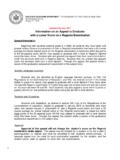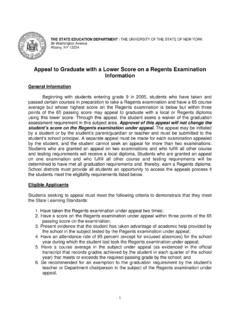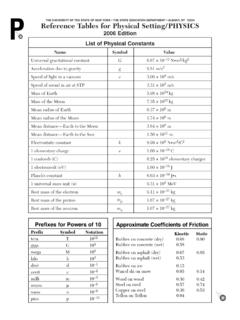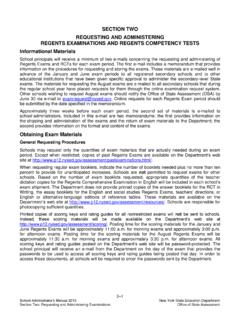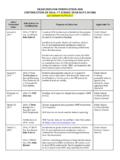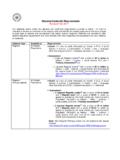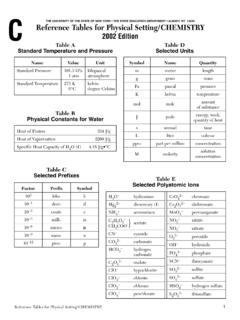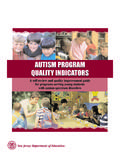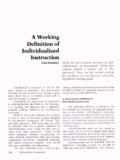Transcription of Guidance for Transporting Oxygen on School …
1 New york State education department Guidance for Transporting Oxygen on School Buses When transportation for a student with Oxygen needs is required by the child's individualized education Program (IEP), the following items should be considered: Does the child require Oxygen to be received during transport? o Do we have a medically qualified person to deliver such needs? What kind of Oxygen will need to be transported with the child and what size and type of tank will be used? o Is this size and type of tank safe to transport on a School bus? o Are any additional safety precautions necessary? What kind of training and emergency planning will the bus staff require to transport this child with Oxygen ?
2 What kind of specialized equipment should be on a bus that transports this child? To answer these questions Transportation Professionals can be referred to NYSED's Reference Materials for Safely Transporting Oxygen on School Buses . New york State education department Reference Materials for Safely Transporting Oxygen on School Buses Purpose: To give School districts, board of cooperative education services, School bus contractors, School bus drivers, School bus monitors, and School bus attendants Guidance on how to safety transport Oxygen on School buses when deemed medically necessary, in accordance with a student's individualized education Program (IEP).
3 This Guidance will include best practices in securement, contingency planning in cases of emergencies such as collisions or vehicle breakdowns, and training guidelines. Oxygen MAY BE SAFELY TRANSPORTED ON A School BUS WITH PROPER PLANNING AND SECUREMENT. Definitions: 1) A School bus driver shall mean any person who drives a School bus which is owned, leased or contracted for by a public School district, board of cooperative education services or nonpublic School for the purpose of Transporting pupils. 2) A School bus shall mean every vehicle owned, leased or contracted for by a public School district, board of cooperative education services or a nonpublic School and operated for the transportation of pupils, children of pupils, teachers and other persons acting in a supervisory capacity to or from School or School activities.
4 3) A School bus monitor shall mean any person employed for the purpose of assisting children to safely embark and disembark from a School bus which is owned, leased or contracted for by a public School district, board of cooperative education services, and for the purpose of assisting the School bus driver with maintaining proper student behavior on such School bus. 4) A School bus attendant shall mean any person employed for the purpose of serving pupils with a disabling condition on a School bus which is owned, leased or contracted for by a public School district, board of cooperative education services. 5) A nonpublic School shall mean a private or parochial School offering instruction in any or all grades, pre-kindergarten through 12.
5 6) Oxygen is a non-flammable substance that is stored in liquid or gas form and is used by a student to aid in breathing, and in many cases, in treating an ongoing medical condition. It is always a prescribed medication and will be considered medical support/needed equipment for a student. 7) Maximum Tank Size should be no more than 38 cubic feet for compressed gas. a) Gas Oxygen Tanks (GOX) are cylinders that come in various sizes and are labeled MEDICAL E tanks. MEDICAL E . tanks are not larger than 22 cubic feet capacity, are approximately 4 inches in diameter, and weigh less than 12 pounds. They are usually not more than 31 inches tall.
6 B) Liquid Oxygen Units (LOX) come in portable containers that are smaller than the gas tanks. Most such units are less than 10 pounds and are no more than 5 inches in diameter. Liquid Oxygen units are not more than 13 inches tall. In order to transport these units they should not be larger than 38 cubic feet. 8) Cryogenic Materials pertain to the production or use of extremely low temperatures. 9) Oxygen Delivery System (ODS) is the device that delivers Oxygen through the upper airways to the lungs at concentrations above that of ambient air. There are two general types: a) High flow Oxygen delivery system, which can supply all of the needs of a patient for inspired gas at a given fractional inspired Oxygen .
7 B) Low flow Oxygen delivery system, which cannot supply all of the patient's needs for Oxygen and delivers fractional inspired Oxygen that varies with ventilatory demand. Note: If a child's IEP dictates a larger tank is needed, the district is not relieved of its responsibility to transport the student. Arrangements should be made to transport the student in an alternative vehicle. Guidelines: 1) Oxygen may be transported on School buses only when it is medically necessary. The individualized education Program (IEP) for a student should document the Oxygen use and transportation requirement. 2) Prior to initial transportation, and pursuant to a physician's order, School administration and transportation personnel should be informed as to the type and size of the Oxygen tank that will be transported.
8 3) If Liquid Oxygen (LOX) is being transported, the vehicle should be equipped with a blanket and gloves to deal with potential frostbite incidents. 4) Prior to initial transportation, School administration and transportation personnel should contact the manufacturer of the Oxygen tank for product specific information regarding Transporting the tank on a School bus. 5) When it is determined through the individualized education Program (IEP) that a student shall be transported on a School bus accompanied by an Oxygen tank and any other medical support equipment, it is strongly suggested that a School bus attendant or nurse also be assigned.
9 6) The determination as to what is considered to be medically necessary and as needed is the responsibility of trained medical personnel only. This decision is not the responsibility of the School district, the School bus driver, or the School bus attendant. 7) It is suggested that only one (1) tank per individual be transported on the School bus whenever possible or in cases of emergencies. 8) The School bus driver and the School bus attendant should be properly trained in the safe handling and securement of the Oxygen tank. They should also be thoroughly familiar with the contingency plan established in the event of a collision or breakdown of the vehicle.
10 However, under no circumstances should the School bus driver or the School bus attendant attempt to administer Oxygen to a student. Training School bus drivers, bus attendants, and substitute drivers should receive the following training prior to Transporting students traveling with Oxygen : Tank Inspection, Handling, and Securement Procedures. Emergency Evacuation Procedures. How to secure the Oxygen and how to handle the Oxygen in case of a bus evacuation. Emergency Bus Procedures o Bus drivers, bus attendants, and substitutes should be familiar with the emergency plan developed by the School nurse in conjunction with the transportation office for each Oxygen dependent student.
